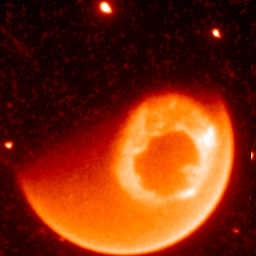 | |
| Type | Geomagnetic storm |
|---|---|
| Formed | 14 July 2000 |
| Dissipated | 16 July 2000 |
| Damage | Minor satellite and terrestrial power transformer damage |
| Areas affected | Worldwide |
Part of Solar cycle 23 | |
The Bastille Day solar storm was a powerful solar storm on 14-16 July 2000 during the solar maximum of solar cycle 23. The storm began on the national day of France, Bastille Day. It involved a solar flare, a solar particle event, and a coronal mass ejection which caused a severe geomagnetic storm.[1][2]
Overview[edit]
Solar flare and particle event[edit]
On 14 July 2000 from about 10:03 to 10:43 UTC, GOES satellites detected a very strong, X5.7-class, solar flare[note 1] which peaked in soft X-ray intensity at around 10:24 UTC. This flare originated from the solar active region AR9077 which was located near the center of the Sun's disk (N22 W02) at the time of the flare.[5][6]
Starting at around 10:41 UTC, GOES satellites began detecting a strong, S3, solar particle event[note 2] associated with the ongoing X5.7-class flare.[1] This resulted in high energy protons penetrating and ionizing parts of the Earth's ionosphere and creating noise in various satellite imaging systems such as in the EIT and LASCO instruments.[3] Some of these particles had sufficient energy to generate effects measured on Earth's surface, an event referred to as a ground level enhancement. Although the flare was not extremely large, the associated solar particle event was the fourth largest since 1967.[6]
Geomagnetic storm[edit]
The detection of the solar flare was also followed by the detection of a halo, or Earth-directed, coronal mass ejection (CME) in coronagraph data starting at 10:54 UTC.[3] This CME reached Earth on 15 July causing a geomagnetic storm on 15-16 July which would reach a peak Kp index of 9+ in the late hours of 15 July corresponding to an extreme-level, or G5, geomagnetic storm[note 3] and register a peak Dst of −301 nT. The storm caused minor damage to power transformers and satellites.[9] It was also one of only two solar storms having registered a maximum Kp of 9+ since the March 1989 geomagnetic storm, the other being the 2003 Halloween solar storms.[10]
Aftermath[edit]
Due to being the first major solar storm since the launch of various solar-monitoring satellites, the Bastille Day event proved important towards helping scientists piece together a general theory of how eruptions on the sun occur as well as protecting the Earth from a larger event, such as a Carrington-class event, some day in the future.[11]
Despite their great distance from the Sun, the Bastille Day event was observed by Voyager 1 and Voyager 2.[12]
See also[edit]
Notes[edit]
- ^ The label X5.7-class implies that the solar flare had a peak soft X-ray flux of 5.7×10−3 W/m2 in the 0.1 to 0.8 nm (1 to 8 Å) passband. (See Solar flare § Soft X-ray classification.)
- ^ The label S3 is assigned to solar particle events which have a flux of protons with energies ≥10 MeV peaking between 103 and 104 proton flux units (or particle cm−2 s−1 sr−1).[7][8]
- ^ The label G5 is assigned to geomagnetic storms which reach a peak Kp index of 9 or more.[7] (See K-index § G-scale.)
References[edit]
- ^ a b "Space Radiation Storm". NASA. 2004-07-14. Archived from the original on 2000-08-15. Retrieved 2007-03-09.
- ^ "NASA Says Solar Flare Caused Radio Blackouts". The New York Times. Associated Press. 2000-07-14. Retrieved 2007-03-09.
- ^ a b c Andrews, M.D. (2001). "Lasco and eit Observations of the Bastille day 2000 Solar Storm". Solar Physics. 204: 179–196. doi:10.1023/A:1014215923912.
- ^ "SOHO Hotshots". soho.nascom.nasa.gov. Retrieved 4 November 2021.
- ^ Reiner, M.J.; Kaiser, M.L.; Karlický, M.; Jiřička, K.; Bougeret, J.-L. (2001). "Bastille Day Event: A Radio Perspective". Solar Physics. 204: 121–137. doi:10.1023/A:1014225323289.
- ^ a b Watari, Shinichi; Kunitake, Manabu; Watanabe, Takashi (January 2001). "The Bastille Day (14 July 2000) event in historical large sun-earth connection events". Solar Physics. 204: 425–438. Bibcode:2001SoPh..204..425W. doi:10.1023/A:1014273227639. S2CID 117394988. Retrieved 2 January 2021.
- ^ a b "NOAA Space Weather Scales | NOAA / NWS Space Weather Prediction Center". www.swpc.noaa.gov. Retrieved 7 August 2022.
- ^ "Solar Radiation Storm | NOAA / NWS Space Weather Prediction Center". www.swpc.noaa.gov. Retrieved 7 August 2022.
- ^ "Minor Damage Reported from Geomagnetic Storm" (PDF). Retrieved 2 January 2021.
- ^ "Top 50 Geomagnetic Storms". Retrieved 2 January 2021.
- ^ Moskowitz, Clara (14 July 2011). "Bastille Day Solar Storm: Anatomy of a Gargantuan Sun Tempest". Retrieved 2 January 2021.
- ^ Webber, W. R.; McDonald, F. B.; Lockwood, J. A.; Heikkila, B. (15 May 2002). "The effect of the July 14, 2000 "Bastille Day" solar flare event on >70 MeV galactic cosmic rays observed at V1 and V2 in the distant heliosphere". Geophysical Research Letters. 29 (10): 15–1–15-3. doi:10.1029/2002GL014729. Retrieved 7 August 2022.

